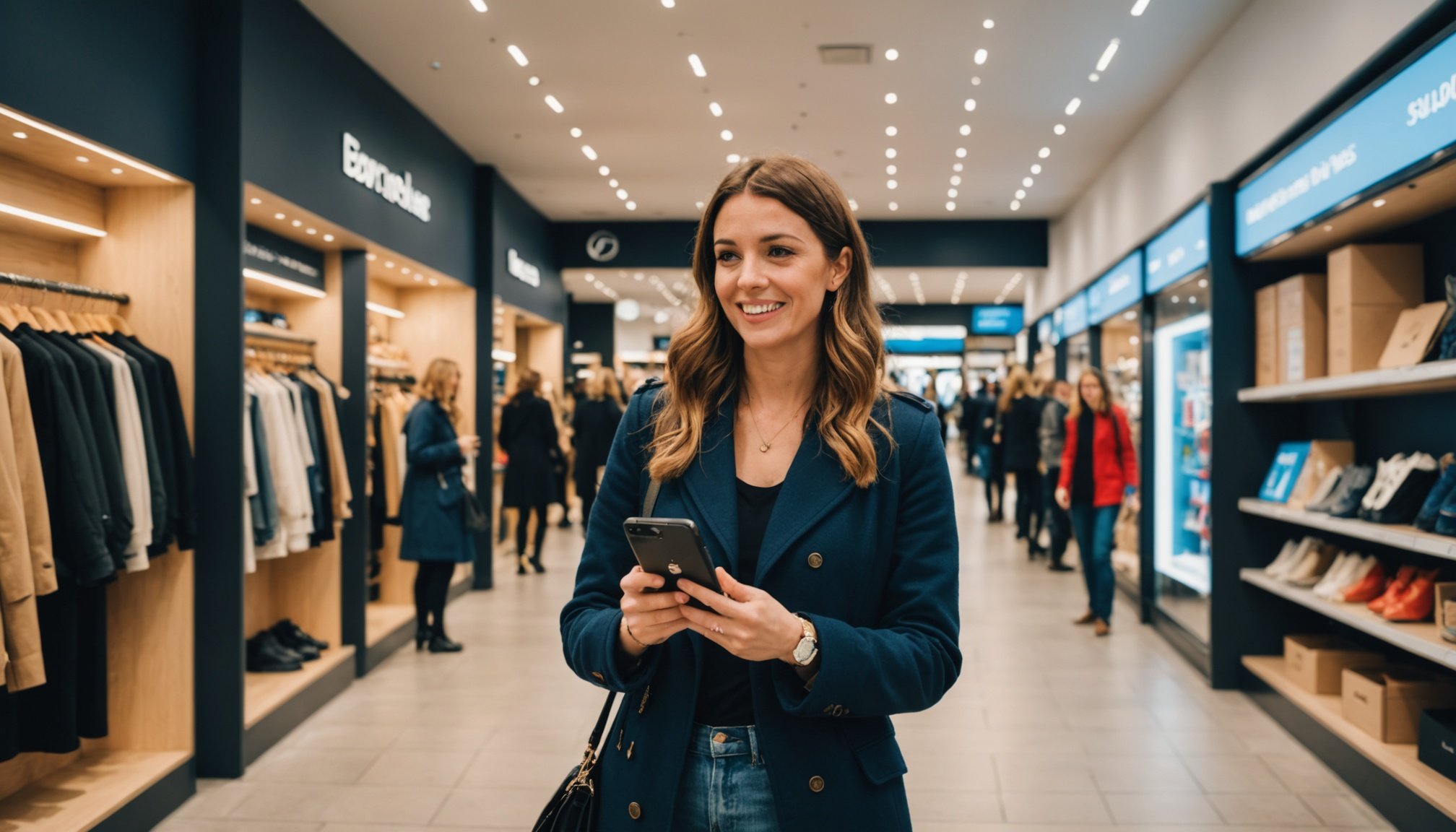Revolutionizing UK Retail: Enhancing Shopper Experience with Cutting-Edge Visual Search Technology
In the ever-evolving landscape of retail, one of the most significant innovations transforming the shopping experience is visual search technology. This cutting-edge tool, powered by artificial intelligence (AI) and machine learning, is revolutionizing how customers interact with online and physical stores. Here’s a deep dive into how visual search is reshaping the UK retail sector.
The Rise of Visual Search in Retail
Visual search technology allows customers to search for products using images rather than text. This innovation is particularly significant in the retail industry, where traditional text-based searches often fall short.
Topic to read : Unlocking Blockchain: UK Startups’ Ultimate Guide to Enhancing Business Transparency
How Visual Search Works
Visual search employs advanced machine learning algorithms to identify objects within images. When a customer uploads a picture or takes a photo of a product, the AI system analyzes the visual data to match it with similar items available in the retailer’s inventory. This process is swift and intuitive, making it easier for consumers to find what they are looking for without the hassle of typing keywords[2][3][4].
Enhancing Customer Experience with Visual Search
The integration of visual search technology has a profound impact on the customer experience, making it more personalized, efficient, and engaging.
Additional reading : Revolutionizing UK Property Management with Digital Twins: A Game-Changer for Real Estate Companies
Personalized Product Recommendations
Retailers like ASOS and Zalando are leveraging visual search to offer personalized product recommendations. For instance, ASOS’s Style Match feature allows customers to upload an image of a product they like, and the AI system suggests similar items based on the visual information such as color, pattern, and style. This not only enhances convenience but also increases the likelihood of a purchase[1][2].
Real-Time Try-Ons and Virtual Fitting Rooms
One of the most compelling applications of visual search is in virtual try-ons and fitting rooms. Warby Parker, for example, uses AI and augmented reality (AR) to let customers try on glasses and sunglasses virtually. This technology creates a 3D map of the customer’s face, ensuring accurate placement and size comparison, thereby reducing the need for physical try-ons and subsequent returns[1][4].
Improving Product Discovery
Visual search significantly enhances product discovery, a critical aspect of the shopping experience.
Reducing Search Friction
Traditional text-based searches can be frustrating, especially when customers are unsure of the exact keywords to use. Visual search eliminates this friction by allowing customers to find products using images. This is particularly beneficial in regions with high demand for style-driven products, where visual cues are more intuitive than text searches[2][4].
Example: Poshmark’s Posh Lens
Poshmark’s Posh Lens is a prime example of how visual search can address common consumer frustrations. This tool lets shoppers search for secondhand fashion items by uploading photos, making it easier for them to find items they like without the need for precise keywords[3].
Revolutionizing In-Store Consumer Experience
Visual search is not limited to ecommerce; it also transforms the in-store shopping experience.
Smart Mirrors and Fitting Rooms
Smart mirrors equipped with visual AI allow customers to see how clothes will look without physically trying them on. These mirrors can suggest accessories or different sizes based on the customer’s choice, enhancing the shopping experience and saving time. For instance, a customer in a clothing store can use a smart mirror to try different outfits virtually and receive recommendations for accessories[2].
In-Store Navigation
Visual AI systems can also guide customers through large stores, helping them find desired products efficiently. This not only increases sales by assisting customers in locating products but also improves the overall store aesthetics and customer experience. A shopper can use their smartphone to navigate a department store, with visual AI guiding them to the exact aisle where their product is located[2].
The Role of Artificial Intelligence and Machine Learning
The backbone of visual search technology is artificial intelligence and machine learning.
Machine Learning Algorithms
Machine learning algorithms are crucial in analyzing visual data and generating meaningful information. These algorithms learn from extensive customer data, including past purchases, browsing behavior, and saved items, to provide personalized search results and product recommendations. Zalando, for example, uses complex AI algorithms to analyze customer data and display products that are most likely to interest each individual based on their unique preferences[1].
Augmented Reality Integration
The integration of augmented reality (AR) with visual AI further enhances the shopping experience. AR allows customers to see how products will look in their homes or on their bodies in real-time. For instance, a furniture retailer can combine AR with visual AI to show customers how items would look in their homes, providing a realistic preview and increasing customer confidence in purchasing decisions[2][4].
Practical Insights and Actionable Advice for Retailers
For retailers looking to implement visual search technology, here are some practical insights and actionable advice:
Structuring Content for AI Interpretation
To make the most of visual search, retailers need to structure their content in ways that make it easier for AI to interpret. This includes using standardized formats, schemas, and metadata that help AI understand the context and details of the content. Semantic HTML tags are also critical to help AI understand the structure and significance of different parts of web pages[3].
Example: Microsoft’s Copilot Vision
Microsoft’s Copilot Vision is an experimental feature that highlights the importance of structured content. This AI-powered assistant helps shoppers compare products, understand features, and make purchases by interpreting web page content in real-time. Retailers can benefit from similar technologies by ensuring their content is AI-friendly[3].
Benefits for Retailers and Consumers
The adoption of visual search technology offers numerous benefits for both retailers and consumers.
Increased Customer Satisfaction
Visual search enhances customer satisfaction by providing a more intuitive and engaging shopping experience. Customers can find products quickly and efficiently, reducing frustration and increasing the likelihood of a purchase. For instance, Walmart’s integration of voice commerce and visual search has improved customer convenience, allowing shoppers to easily access information about their previous purchases and preferences[1].
Improved Conversion Rates
By reducing search friction and providing personalized product recommendations, visual search can significantly improve conversion rates. Retailers like Benuta have seen the benefits of personalized search and product discovery platforms, which guide customers intuitively to products that best suit their preferences[5].
Challenges and Future Developments
While the benefits of visual search are clear, there are also challenges and areas for future development.
Privacy Concerns
One of the significant challenges is ensuring privacy. Microsoft, for example, has emphasized that its Copilot Vision feature does not use website data to train its AI models, and all session data is deleted after use. Retailers must prioritize privacy to build trust with their customers[3].
Future Integration with Edge Technologies
The future of visual search is promising, with potential integrations with edge technologies like AR and more advanced AI algorithms. As technology advances, visual search is likely to become more precise and faster, becoming a standard feature on ecommerce platforms. This will further enhance the shopping experience, providing customers with a more realistic and immersive way to discover and purchase products[2].
Visual search technology is revolutionizing the retail industry by providing customized and immersive shopping experiences. Whether through online or in-store approaches, visual AI plays a crucial role in enhancing customer engagement and satisfaction. As retailers continue to adopt and refine these technologies, the future of retail looks brighter than ever, driven by the power of visual artificial intelligence.
Detailed Bullet Point List: Key Benefits of Visual Search in Retail
- Enhanced Customer Experience: Provides a more intuitive and engaging shopping experience by allowing customers to search for products using images.
- Personalized Product Recommendations: Offers personalized product suggestions based on visual information, increasing the likelihood of a purchase.
- Real-Time Try-Ons and Virtual Fitting Rooms: Reduces the need for physical try-ons and subsequent returns by allowing customers to try on products virtually.
- Improved Product Discovery: Reduces search friction by enabling customers to find products quickly and efficiently.
- Increased Customer Satisfaction: Enhances customer satisfaction by providing a seamless and user-friendly shopping experience.
- Improved Conversion Rates: Increases conversion rates by guiding customers to products that best suit their preferences.
- In-Store Navigation: Helps customers navigate large stores efficiently, improving the overall store aesthetics and customer experience.
- Integration with AR: Combines with augmented reality to provide a realistic preview of how products will look in real-world settings.
- Structured Content for AI: Ensures content is structured in ways that make it easier for AI to interpret, enhancing the effectiveness of visual search.
Comprehensive Table: Comparison of Visual Search Features in Retail
| Retailer | Visual Search Feature | Key Benefits | Technology Used |
|---|---|---|---|
| ASOS | Style Match | Personalized product recommendations, reduced search friction | Machine learning algorithms, visual AI |
| Zalando | Personalized search results | Personalized product suggestions, dynamic filters | Complex AI algorithms, machine learning |
| Warby Parker | Virtual try-on | Real-time try-ons, reduced returns | AI, augmented reality |
| Walmart | Voice commerce and visual search | Improved customer convenience, easy access to previous purchases | Voice-activated platforms, visual AI |
| Poshmark | Posh Lens | Easy search for secondhand fashion items, reduced search friction | Machine learning algorithms, visual AI |
| Benuta | Personalized search and product discovery | Guided product discovery, improved conversion rates | Constructor’s AI Shopping Assistant |
Relevant Quotes
- “Our customers are all unique, and their interior spaces reflect their styles and lives. With Constructor’s personalisation features, we can help shoppers quickly and enjoyably discover their dream rugs.” – Andreas Fischer, Head of Ecommerce Technologies, Benuta[5].
- “This could include the use of standardized formats, schemas and metadata that help AI understand the context and details of the content.” – Elizabeth Gwinner, Lead AI Solutions Vision Engineer and Content Strategy Expert, CadenceSEO[3].
- “Businesses can bid for priority placements using Copilot Vision, allowing their goods or services to show up as highlighted choices when AI makes recommendations based on user preferences.” – Jacob Edwards-Bytom, Founder of UltraLabs[3].
By embracing visual search technology, retailers in the UK can significantly enhance the shopping experience, drive customer satisfaction, and stay ahead in the competitive retail landscape. As this technology continues to evolve, it promises to transform the way we shop, making it more intuitive, engaging, and personalized than ever before.











